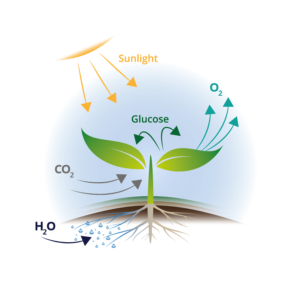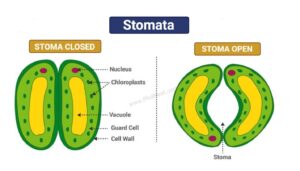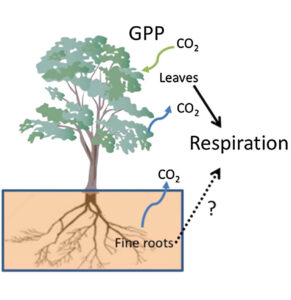Respiration Definition?
When you hear the word ‘respire or Respiration,’ you probably think of breathing. When you breathe, you are taking in oxygen with each inhale and releasing carbon dioxide with each exhale. This gas exchange is important for respiration, but while breathing is a physical process, respiration can be thought of as more of a chemical process. All organisms, from a single bacterial cell to a coral reef colony to a blue whale, undergo respiration.
Food molecules absorbed after digestion are taken in, broken down, and the energy freed in the process is used to power the organism’s movements and physiological functioning. Respiration is the biochemical process in which the cells of an organism obtain energy by combining oxygen and glucose, resulting in the release of carbon dioxide, water, and ATP (the currency of energy in cells).
What is Plant Respiration?
The method by which cells get chemical energy by the consumption of oxygen and the liberating of carbon dioxide is called respiration. In order to carry on respiration, plant cells require oxygen and a means of disposing of carbon dioxide just as animal cells do. In plants, every part such as root, stem executes respiration as plants do not possess any particular organs like animals for the exchange of gases.
Cellular respiration – Mechanism of the breakdown of food material within the cell to release energy and trap it for ATP synthesis.
Photosynthesis – Chloroplast, breakdown of the molecule to release energy – cytoplasm, and mitochondria.
Respiration – Breaking of C-C bonds of the complex compound through oxidation within the cell to release energy.
Respiratory Substrates – Compounds that are oxidized in respiration. E.g., Carbohydrates, fat, protein.
Do Plants Breathe?
Plants do not require respiratory organs because-
- Each plant part takes care of its own gas exchange needs.
- They do not present great demands for gas exchange. (Low O2). Roots, Steam, leaves respire at rates for less than animals.
- The distance that gases must diffuse is not great (parenchyma cells).
- O2 fulfills O2 demand during photosynthesis (end product). Plants have at least a part of their surface in contact with air. It is facilitated by loose packing of parenchyma cells in leaves, stems which provide an interconnected network of air spaces.
- C6H12O6 + 6O2 → 6CO2 + 6H2O + energy
Click Here for Complete Biology Notes
Process of Respiration in Plants
During respiration, in different plant parts, significantly less exchange of gas takes place. Hence, each part nourishes and fulfils its own energy requirements.
Consequently, leaves, stems and roots of plants separately exchange gases. Leaves possess stomata – tiny pores, for gaseous exchange. The oxygen consumed via stomata is used up by cells in the leaves to disintegrate glucose into water and carbon dioxide.
Respiration In Leaves
The leaves of plants have tiny pores on their surface which are called stomata. The exchange of gases in the leaves during respiration takes place through stomata.
This happens as follows: Oxygen from the air enters into a leaf through stomata and reaches all the cells by the process of diffusion. This oxygen is used in respiration in cells of the leaf. The carbon dioxide produced during diffuses out from the leaf into the air through same stomata.
The photosynthesis reaction makes glucose and the respiration reaction break it down. In photosynthesis, the energy which goes into the reaction is light energy. In respiration, the energy which comes out is chemical energy.
Respiration in Roots
The roots of plants are under the ground but root cells also need oxygen to carry out respiration and release energy for their own use. The roots of a plant take up air from the spaces between the soil particles. Root hairs are in contact with the air in the soil particles. Oxygen from the air in soil particles diffuse into root hair and reach all the cells of the root where it is utilised in respiration. Carbon dioxide produced in the cells of the root during respiration goes out through the same root hair by the process of diffusion.
If a potted plant is over watered for a long time, then the plant may ultimately die. This is because too much water expels all the air from in between the soil particles. Due to this, oxygen is not available to the roots for aerobic respiration. In this condition, the roots of plant respire anaerobically producing alcohol. This may kill the plant. Germinating seeds during early stage respire anaerobically because they have seed coat which does not allow the oxygen to enter through it.
Differences between Respiration and Photosynthesis
| Photosynthesis | Respiration |
| This process is common to all green plants containing chlorophyll pigments. | This process is common to all living things, including plants, animals, birds, etc. |
| Food is synthesized. | Food is oxidised. |
| Energy is stored. | Energy is released. |
| Is an anabolic process. | Is a catabolic process. |
| Cytochrome is required. | Cytochrome is required here too |
| It is an Endothermal process. | It is an Exothermal process. |
| It comprises products such as water, oxygen and sugar | It comprises products such as carbon dioxide and hydrogen |
| Radiant energy is converted into potential energy. | Potential energy is converted into kinetic energy. |
| Occurs during daytime in the presence of sunlight only. | Is a continuous process, taking place all through the lifetime |
Types of Respiration
There are two kinds of respiration which we categorize on the basis of the absence or presence of oxygen:
Aerobic Respiration
The respiration that occurs in the presence of oxygen is named aerobic respiration due to ‘air’ which has oxygen. The aerobic respiration contains utilization of oxygen for the breaking of chemical bonds in glucose to liberate energy in high volumes. It is the central source of energy for plants. Animals and plants that use oxygen for respiration are aerobes. Mostly all the animals have aerobic respiration.
C6H12O6 +6O2 ⟶ 6CO2 + 6H2O + Energy
All the organisms that gain energy by aerobic respiration cannot exist without oxygen. This is due to no oxygen there; they cannot get energy from the food which they consume. Aerobic respiration takes more energy because a complete breaking of glucose takes place during respiration with the use of oxygen.
Anaerobic Respiration
The respiration that occurs in the absence of oxygen is known as anaerobic respiration. In this process, the incomplete oxidation of food substance is being made by carbon dioxide CO2 and alcohol(OH). Beside this other organic matter such as citric acid, oxalic acid, lactic acid, etc are also produced.
This process is also called intramolecular respiration. The anaerobic respiration occurs in organisms like yeast, certain bacteria, and parasitic worms. The animals and plants that can exist and gain energy even in the lack of oxygen are called Anaerobic.
Glucose ⟶ Alcohol + CO2 + (Energy)
Yeast is known to be a single-celled fungus. In yeast, a single cell signifies the whole organism. Very low volume of energy is liberated in this process. Yeast respires anaerobically and all through this process, yeast transforms glucose into alcohol. So it is used to make alcohol, bread, etc.
Anaerobic respiration yields much less energy due to the only partial break down of glucose happens in anaerobic respiration in the absence of oxygen. All the organisms which gain energy by anaerobic respiration can exist without the oxygen.
Related Posts
- Phylum Porifera: Classification, Characteristics, Examples
- Dissecting Microscope (Stereo Microscope) Definition, Principle, Uses, Parts
- Epithelial Tissue Vs Connective Tissue: Definition, 16+ Differences, Examples
- 29+ Differences Between Arteries and Veins
- 31+ Differences Between DNA and RNA (DNA vs RNA)
- Eukaryotic Cells: Definition, Parts, Structure, Examples
- Centrifugal Force: Definition, Principle, Formula, Examples
- Asexual Vs Sexual Reproduction: Overview, 18+ Differences, Examples
- Glandular Epithelium: Location, Structure, Functions, Examples
- 25+ Differences between Invertebrates and Vertebrates
- Lineweaver–Burk Plot
- Cilia and Flagella: Definition, Structure, Functions and Diagram
- P-value: Definition, Formula, Table and Calculation
- Nucleosome Model of Chromosome
- Northern Blot: Overview, Principle, Procedure and Results


















